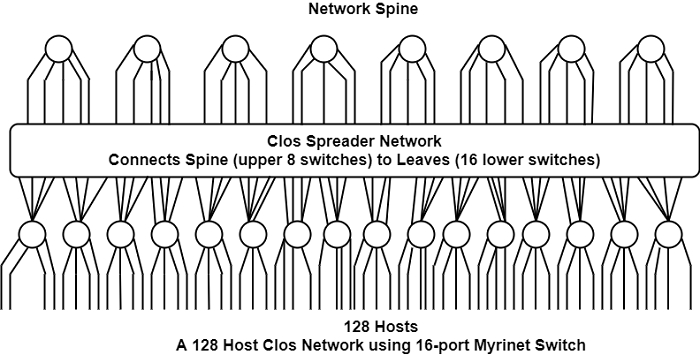
 Data Structure
Data Structure Networking
Networking RDBMS
RDBMS Operating System
Operating System Java
Java MS Excel
MS Excel iOS
iOS HTML
HTML CSS
CSS Android
Android Python
Python C Programming
C Programming C++
C++ C#
C# MongoDB
MongoDB MySQL
MySQL Javascript
Javascript PHP
PHP
- Selected Reading
- UPSC IAS Exams Notes
- Developer's Best Practices
- Questions and Answers
- Effective Resume Writing
- HR Interview Questions
- Computer Glossary
- Who is Who
What is Myrinet Clos Network?
Myrinet is a high-performance, packet-communication, and switching technology. It was produced by Myricom as a high-performance alternative to conventional Ethernet networks. Myrinet switches are multiple-port components that route a packet entering on an input channel of a port to the output channel of the port selected by the packet.
Myrinet switches have 4, 8, 12, 16 ports. For an n-port switch, the ports are addressed 0, 1, 2... n - 1. For any switching permutation, there may be as many packets traversing a switch concurrently as the switch has ports. These switches are implemented using two types of VLSI chips such as crossbar-switch chips and the Myrinet-interface chip.
The basic building block of the Myrinet-2000 network is a 16-port Myrinet crossbar switch, implemented on a single chip designated as Xbar16. It can be interconnected to build various topologies of varying sizes. The most common topology is the Clos network.
As shown in the figure, it includes 24 Xbar16s. Each Xbar16 switch is represented using a circle. The eight switches forming the upper row is the Clos network spine, which is connected through a Clos spreader network to the 16 leaf switches forming the lower row.

The Clos network provides routes from any host to any other host. There is a unique shortest route between hosts connected to the same Xbar16. Routes between hosts connected to different Xbar16s traverse three Xbar16 switches.
The routing of Myrinet packets is based on the source routing approach. Each Myrinet packet has a variable-length header with complete routing information. When a packet enters a switch, the leading byte of the header determines the outgoing port before being stripped off the packet header. At the host interface, a control program is executed to perform source-route translation.

